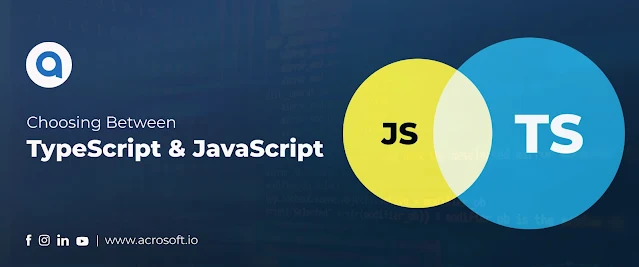Two popular programming languages that are often used in web application development are TypeScript and JavaScript. TypeScript is an advanced version of JavaScript with numerous additional optional capabilities and a key differentiator (static typing), while JavaScript is a widely used language that serves as a catalyst for the web.
It doesn't matter if you're a beginner or an expert developer. All the information you require to choose between the two programming languages is provided here. You will understand the distinctions between TypeScript and JavaScript better by the end of it.
Furthermore, if you're looking to build web applications using either TypeScript or JavaScript, Acrosoft offers a suite of development services to cater to your specific needs. From custom web development and API integration to performance optimization and secure coding practices, Acrosoft's team of experienced developers can help you bring your ideas to life using the latest advancements in both languages.
What is JavaScript?
One of the most widely used computer languages for web development is JavaScript, or JS for short. It is a cross-platform, lightweight scripting language with great versatility and strength. JS was created with the objective of improving web pages interactivity and making them more interesting and user-friendly.
The language used for client-side scripting is called JavaScript. It indicates that consumers can utilize this language in their web browsers. In this language, the programs are referred to as scripts. Without waiting for the page to load, developers can implement dynamic modifications by writing scripts inside HTML pages.
Why is JavaScript used?
JavaScript is used for many purposes:
- Web Development
The most well-known and frequently used technology for creating web apps is JavaScript. A developer is aware that the fundamental language for front-end programming is JavaScript.
- Game Development
- Mobile App Development
The most popular and extensively used JS framework right now is React Native. Its cross-platform mobile app development capabilities are so good that software developers love it.
- Server-side development
If you use JavaScript with Node.js, it can also be utilized for server-side development.
Pros of JavaScript
Here are a few incredible benefits of using JavaScript:
- Programming languages such as JavaScript are useful for both server-side and front-end development.
- There is a large and vibrant JavaScript community with many of resources and libraries available.
- JavaScript's dynamic typing enables quick development and prototyping.
- Because JavaScript is compatible with most recent browsers, it doesn't require any extra settings to run.
- Errors are quickly identified during runtime while utilizing JS.
Cons of JavaScript
- Runtime issues may result from a lack of static typing.
- With big codebases, it is prone to mistakes.
- JavaScript's tooling is less sophisticated than TypeScript's.
- Security problems because the client side is running the JS code.
What is TypeScript?
Microsoft developed TypeScript, which is often abbreviated as “TS”. It is an object-oriented programming language that is pure and flexible, and it is available for free. Since TypeScript is a premium superset of JavaScript, all of your legitimate JS code will also be TypeScript code.
It is not possible to run TS directly in the browser; instead, a compiler is needed to compile and create a JS file. '.ts' is the extension of the TypeScript source file. You can utilize any genuine ".js" file by renaming it to a ".ts" file.
Static typing is a major differentiator of TypeScript. It is an improved version of JavaScript that improves the quality of code while it's being developed.
Why is TypeScript used?
TypeScript has several uses. Top TypeScript applications include the following:
- Static typing is TypeScript's primary advantage. It assists developers in writing robust, well-written code and preventing runtime issues.
- Developers can benefit from improved tooling and intelligent code completion using TypeScript. It guarantees a productive and easy-going development procedure.
- The current programming language, TypeScript, is simple to use and read. Its high readability factor makes code understanding in addition to upkeep quick.
- Large codebases and collaborative development are two scenarios where TypeScript is really beneficial since type safety is essential.
Data Types of TypeScript
Will TypeScript Replace JavaScript
Obviously, the answer to this question is NO! JavaScript won't be replaced by TypeScript. TypeScript is a completely distinct language, although it shares many fundamental characteristics with JavaScript. The goals and advantages of the two programming languages are different. For this reason, TypeScript cannot and will not replace JavaScript.
JavaScript holds significant value as a programming language and technology within the software development industry. It is used by developers for both client-side and server-side development. However, TypeScript is not directly compatible with web browsers. JavaScript is compiled from TypeScript trans. Furthermore, it is especially useful for larger projects that call for scalability and robust typing.
TypeScript vs JavaScript: What’s the Actual Difference?
Programming languages TypeScript and JavaScript are similar, although they differ significantly. JavaScript is a scripting language that uses dynamic typing. It is widely used by developers for front-end web development. Because of its versatility and cross-browser compatibility, JavaScript is a necessary language for web development.
But a lot of developers say it doesn't have static typing. It frequently results in runtime errors, which are difficult to identify and fix during the development phase.
Conversely, TypeScript is a subset of JavaScript. Programmers can now notice errors during development instead of at runtime, and static typing is included. As a result, the code is stronger and easier to maintain. Moreover, TypeScript incorporates elements from upcoming ECMAScript specifications.

Comments
Post a Comment